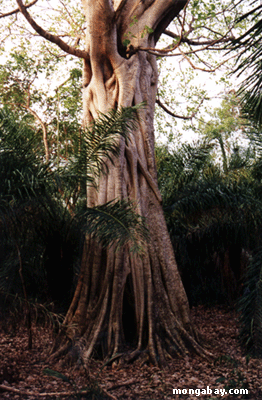TROPICAL RAINFORESTS: The Canopy
THE STRANGLER FIG
Perhaps the most famous hemiepiphyte is the towering strangler fig tree which starts life as |
|
Strangler Fig, Brazil 1999 |
Almost ironically, this agent of death provides an important niche and food source to many rainforest creatures. Its hollow trunk, with an abundance of nooks and crannies, provides an important home to thousands of invertebrates, rodents, bats, reptiles, amphibians, and birds. Many other species are attracted to the fig tree because of its production of large amounts of good-tasting fig fruits. These fruits are packed with seeds, many of which are not destroyed when they are consumed, and are passed out in the dung of animals far from the mother tree. In many forests the fig tree is considered a keystone species since during parts of the year it is virtually the only tree producing fruit. During these lean times, many primates and birds feed almost exclusively on fig fruit.
The fig tree is a successful forest species, with some 900 species of Ficus distributed around the world thanks to its excellent means of dispersal (abundant, good-tasting fruit). But its reproduction is limited by a mutual evolutionary pollination relationship with the gall wasp. The fruits (figs) of the ficus tree grow in clusters on short stems that spring directly from the tree trunk. Each fig has a tiny hole, an entrance just large enough for the female gall wasp, full of eggs, to enter. As she squeezes through the entrance, she loses both her wings and is unable to leave after entering. She deposits the pollen that she has carried and lays her eggs in the stigma of the flowers within the fig seed. Then she dies, and the hole in the fig wall closes. After a few days, the young male wasps—which develop faster than females—hatch and chew open the eggs of the females and mate with them. The males then chew a hole in the wall of the fig fruit and proceed to die. On the way out, the winged females are tagged with pollen. The female wasps, now full of eggs, can only make one flight with their delicate wings. In that one flight, the female must not only find the right species of fig, but one in the right stage of development. If she fails, she will not have the strength to make another flight. If she happens upon the correct species with the right characteristics, she will reenact the process of her mother, ensuring another generation of wasps, and hence another generation of Ficus.
Continued: Rainforest Overstory